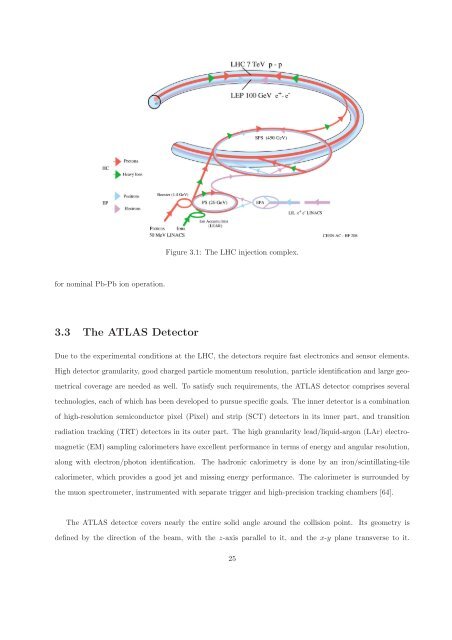CERN-THESIS-2012-153 26/07/2012 - CERN Document Server
CERN-THESIS-2012-153 26/07/2012 - CERN Document Server
CERN-THESIS-2012-153 26/07/2012 - CERN Document Server
Create successful ePaper yourself
Turn your PDF publications into a flip-book with our unique Google optimized e-Paper software.
for nominal Pb-Pb ion operation.<br />
3.3 The ATLAS Detector<br />
Figure 3.1: The LHC injection complex.<br />
Due to the experimental conditions at the LHC, the detectors require fast electronics and sensor elements.<br />
High detector granularity, good charged particle momentum resolution, particle identification and large geo-<br />
metrical coverage are needed as well. To satisfy such requirements, the ATLAS detector comprises several<br />
technologies, each of which has been developed to pursue specific goals. The inner detector is a combination<br />
of high-resolution semiconductor pixel (Pixel) and strip (SCT) detectors in its inner part, and transition<br />
radiation tracking (TRT) detectors in its outer part. The high granularity lead/liquid-argon (LAr) electro-<br />
magnetic (EM) sampling calorimeters have excellent performance in terms of energy and angular resolution,<br />
along with electron/photon identification. The hadronic calorimetry is done by an iron/scintillating-tile<br />
calorimeter, which provides a good jet and missing energy performance. The calorimeter is surrounded by<br />
the muon spectrometer, instrumented with separate trigger and high-precision tracking chambers [64].<br />
The ATLAS detector covers nearly the entire solid angle around the collision point. Its geometry is<br />
defined by the direction of the beam, with the z-axis parallel to it, and the x-y plane transverse to it.<br />
25















